

 The South African
The South African
The coastline of Angola was relatively unprotected from a seaward assault. Amphibious operations could thus be staged by the SA Navy anywhere as a nighttime unopposed landing. To this end, in 1983 the SA Navy started to refit the SAS Tafelberg for amphibious operations. Six utility work-boats that could be modified as landing craft were also procured for this purpose.
In 1984, SAS Tafelberg completed its refit under Cdr. Brown. The flight deck and two hangers could accommodate Super Frelon, Puma, and Allouette helicopters. The boat deck had a practical rail system and four davit stations that allowed boats to launched from either side or launched simultaneously. The ship had a separate mess for a Marine Amphibious Company and a separate air crew mess. A lift operated between the flight deck and mess deck. And the ship had a medical surgery with an operating theatre on the boat deck. Getting personnel, vehicles, or stores from ship to shore at night requires a high level of operational command and competence. The unit that engaged in those ship to shore operations was the Amphibious Boat Squadron.
In August 1984, in conjunction with the completion of the refit, 1 Marine Brigade formed a team to develop operating procedures for landing on beaches, as well as launching and recovering off SAS Tafelberg. The team was given the first D-80 landing craft.
The D-80 started its life as series five Rotork Sea Truck. The Sea Truck was originally designed as a utility work boat for use in harbours and estuaries. It has a flat bottom with two keels running the length of the boat and a flat ramp door at the front. The boat’s overall length is 7.24 meters, the width is 2.95 meters, and the ramp width is 1.85 meters. Standard empty weight is 1800kg and it is powered by two outboard engines. The draft at speed (on the plane) is 18 inches (0,46m) and the draft when travelling slowly (off the plane) is 10 inches (0.25m). The D-80 has 5.70 cubic meters of buoyancy material in the flat hull that acts as a raft. The flat hull has a cruciform inner structure that gives it strength and stability. The ramp, when closed, is sealed watertight with a soft, hexagonal, expanded foam rubber tube which is about 8 cm in diameter.
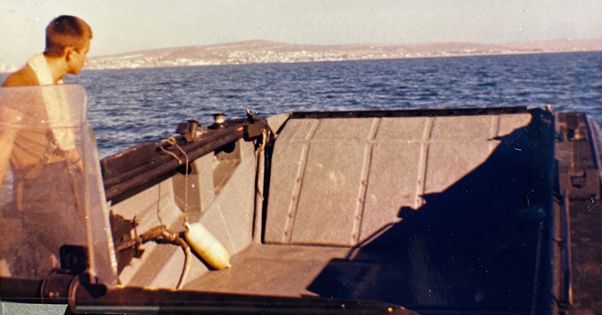
Dale Williams in a D-80 boat going to Donkergat, Langebaan. ABS photo
The D-80 is designed to skate over the water on a cushion of foam, considerably reducing frictional resistance. This is done by the forward movement of the boat ramming air under the boat between the two outer, sharp and deep keels. This rammed air trapped between the outer keels creates lift, generates water foam under the boat, and flattens the water underneath the boat. The result is a foam cushion under the boat which is enhanced by broken air flow caused by the two inner flat keels and trapped by the two deep outer keels. This foam cushion supports main weight of the boat, creating lift and reducing drag to minimum. The faster the boat moves, the more air is rammed under the boat, which in turn generates more lift and less drag. The boat thus operates at its maximum efficiency when travelling faster than 40 knots.
The D-80 was powered by two Yamaha 175HP outboard engines, with a three blade 17 inch propeller pitched for a mixture of power and speed. Two of the boats were fitted with 2 x 200HP engines (with the same 17 inch propellers) so they could also transport heavy loads, such as vehicles, and engage in towing operations. The top speed of the D-80 boats is not known, as those records are lost. However, one was tracked travelling on open water in False Bay by a Strike Craft radar at a speed of 55knts. The boat had two 200 litre fuel tanks which were filled with steel mesh called “explosafe” and carried an approximate total of 370 litres of petrol. The explosafe is designed to prevent a round or shrapnel from hitting the petrol tank, thereby causing an explosion and fire. This fuel load allowed approximately 6 hours of conservative running time in optimal conditions with a range of about 250nm for the 200HP engines, slightly more for the 175HP engines. The rate of petrol usage was quite high. Running the engines at 4000 to 4500 rpm gave a speed of 45 to 50 knots and used about 80 litres of petrol an hour. Running at 3600 to 3700 rpm gave a speed of 32 to 33 knots and used about 60 litres per hour. Running at 1400 rpm gave 6 to 7 knots, was off the plane (behind its own bow wave) and used about 22 litres per hour. The 175HP engines used less fuel while giving the same speed. The 175HP out-board engines create an approximate noise level of 68 decibels at cruising speed (3500 rpm) and 78 decibels at high speed (4500 rpm). ABS operated at night, and 4 foot waves breaking on a beach at night have a decibel level of approximately 68 to 70 decibels. A sound box was built around the engines making the boat relatively silent from the front and sides. The boats were initially light grey, but in 1986 they were repainted dark grey making them almost invisible on the sea at night.
The D-80 landed by riding on the back of a wave and lifting the stern legs as the water shallowed. An anchor was dropped outside the breaker line and an anchor rope ran over the stern from an aft anchor rope locker. Once the boat had landed a second anchor was placed on the beach to keep the bow stable. The boat was then recovered off the beach by using the anchor to pull the boat into water that was deep enough to allow the engines to start. The boat then used power to follow the anchor line out to the anchor, picked up the anchor, and proceed out of the beach area. Landing requires skill as the boat can’t get too close to the wave in front or it will get sucked over the wave when the wave breaks. This has the potential to cause the boat to roll in the surf and kill the occupants. Likewise, the boat can’t fall too far behind the wave as the wave behind will pick the boat up and roll it.
During August 1984, six D-80 craft were delivered by flatbed truck, one by one. Coxswains and crews were selected from 1 Marine Brigade. Practice landings started at Glencairn and Fish Hoek Beaches. Trials for launching and recovering then started with SAS Tafelberg. This was initially done alongside in Simonstown’s harbour. The Tafelberg’s davit stations lowered two, extremely heavy, solid steel spreader bars, with hooks on the ends, into the boat on two large steel blocks from the davit station. The hydraulic davits at this stage had no damping and operated at one speed up and one speed down. This system was used for a while with a few injuries. Changes were made, in that the spreader bars were replaced with hollow aluminium tubes, the open hooks were replaced with shackles, and a detachable three foot rope was inserted between the block and the spreader bars (foul weather strop). To ensure the davit system operated properly, Tafelberg sent P.O. Mark Hildesheim on a hydraulic course at SAS Wingfield. Davit operation fell within the seaman’s branch and the ships buffer, P.O. Brian Hufkie, was the main operator.
SAS Tafelberg then loaded up the D-80 boats with crew and sailed for Langebaan. Operational procedures were worked out for the boats and helicopter operations. The ship needed to sail into the wind for optimum conditions to launch the helicopters. But the ship needed to sail in a . large circle for optimum conditions to launch the D-80 boats. The circular movement flattened the water and gave shelter from waves.
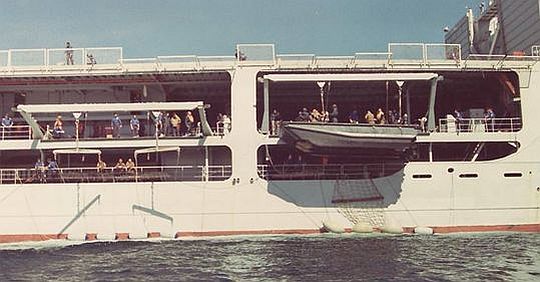
L-21 hanging in aft portside davit. Boat in
forward portside davit has just cleared SAS Tafelberg.
ABS photo.
At the end of 1985, the Marine boat unit was officially named the Amphibious Boat Squadron, or ABS. The Unit comprised, at any one time, around 25 to 26 operational Marines, and staying at ABS was voluntary. ABS was designated as classified and based in the SA Navy’s East Yard. This then became one of the SADF’s open secrets. To the pubic there was clearly an operational boat capability. But information on who they were, and what they did, was unavailable.
On amphibious operations, the helicopter and boat operations on and around SAS Tafelberg were controlled and coordinated by the SAS Tafelberg Operations Officer (OPSO). The individual helo operations were controlled by an Air Force Officer (MAOT). The launching and recovery of boats on the boat deck was controlled by the SAS Tafelberg Executive Officer (XO). D-80 boat operations were controlled by an ABS Marine Officer and Warrant Officer. The beach with its landing site was controlled by an ABS Marine Warrant Officer (Beach Master). Each D-80 boat was under the command of its coxswain. Amphibious orders came to SAS Tafelberg from Chief of Navy, to The Director of Naval Operations, to the Rear Admiral in charge of ships at Silvermine. Amphibious orders came to ABS from, Chief of Navy, to The Director of Naval Operations, to the Senior Staff Officer Marines, to the Officer Commanding 1 Marine Brigade, to the Officer Commanding the ABS. There was a Marine liaison officer at Silvermine, Cdr. McDonald, who was the “go between” for the Navy Rear Admiral in charge of ships and Officer in Command of 1 Marine Brigade.
Having established operating procedures for launch, recovery, and landing, ABS started coordinating boat operating procedures with 4 Reconnaissance Regiment in Langebaan. Joint exercises with 4RR and ABS were done in the area around Langebaan and St Helena during 1985 and 1986.The boats started running at high speed in a v formation with inches between the boats. The exercises were done during the day and at night. All navigation was done by dead reckoning. No GPS, radar, or other navigation aides were used.
For operations SAS Tafelberg would stay in international waters during the day. At nautical twilight she would darken ship and move towards the coastline, taking up station about 12nm offshore; this being over the horizon. The D-80’s would launch and travel between the target beach and the ship in the dark, there was never a navigation problem. An example of this was during operation RADCOL. SAS Tafelberg sailed up the west coast to Bosluis Bay, which is about 5nm miles south of the Angola border. On her way up, SAS Tafelberg passed Walvis Bay in the night while out at sea and over the horizon. ABS launched from SAS Tafelberg and drove into Walvis Bay Harbour, where they picked up classified operational equipment that had been left at the end of the Navy jetty under a tarpaulin. Having collected the equipment, ABS drove out of Walvis Bay Harbour and rejoined SAS Tafelberg which was still heading North and still over the horizon. All done by dead reckoning -a testament to the quality of education provided at the Navy’s Navigational school, the Marines Boat School, and the competence of the ABS coxswains and crew. In 1986 ABS personnel qualified as Navy divers -their purpose being removal of landing obstacles and beach reconaissance before a landing.
In September 1985, the first joint 4RR and ABS amphibious operation took place off Inhambane, Mozambique. This involved four D-80 boats with ABS and four Barracuda boats with 4RR.The operation was successful.
In May 1986,the second amphibious operation took place up the West Coast. ABS and two D-80 boats were deployed with the SAS Tafelberg as a support element for 4RR in operation DROSTY.
In August 1987, the third amphibious operation took place up the West Coast. SAS Tafelberg with two D-80 boats and ABS crews went up to the Cunene river mouth, as support for 4RR, on operation RADCOL.
In August 1987, ABS did a sea survival course, designed and run by Kmdt. Louis Schmidt from 7 Medical Battalion. This was called AMPHISEE and was the precursor to what would become the official ABS unit course. In attendance as safety personnel were several medics and two divers from the SAN Operational Dive Team, Pieter van der Westhuizen and Dave Gibbs. The course covered the theory and practice of survival, interrogation resistance, water movement, waves, and the beach environment.
In November 1987, the fourth amphibious operation took place. SAS Tafelberg sailed up the East Coast to Quelimane, Mozambique for operation BAGDON, a joint ABS and 4RR operation. ABS took three D-80 boats with two boat teams, and 4RR took Barracuda and Avalanche boats.
On November 31, the fifth amphibious operation took place. ABS sailed on SAS Tafelberg to Mauritius with two D-80 boats for operation RESOLVE. Two Puma helicopters from 30 Squadron under the command of Cmdt. Rod Penhall were also on board. The operational task was to find wreckage and the black boxes from the 747 aircraft SAA Helderberg which had crashed. SAS Tafelberg sailed to Durban and then on to Port Louis, Mauritius. The Strike Craft SAS Jim Fouche served as an advance escort. The Navy Port Maintenance Unit in Simonstown sent L.S. Albert Deventer as a boat mechanic for the D-80 engines. At the end of a successful operation, SAS Tafelberg entered Simonstown harbour on January 04, 1988.
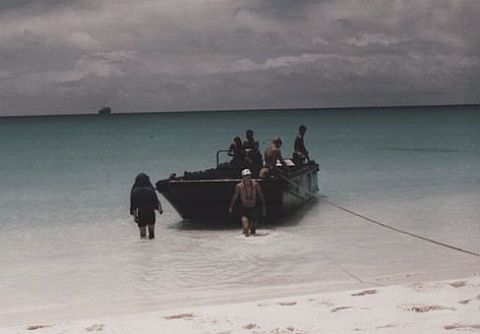
D-80 on the beach on the Cocos Island.
SAS Tafelberg visible on the horizon -
Operation RESOLVE (ABS photo)
On Monday, April 11 1988, SAS Tafelberg sailed from Simonstown to Saldanha Bay for exercise SANDPEBBLE with ABS and four D-80 boats. She anchored off the iron ore jetty at midnight. Kmdt. MacGill Alexander and officers of 44 Parachute Battalion were ordered to attend the exercise. SANDPEBBLE was a day and night exercise involving landing a company of Marines off SAS Tafelberg onto the beaches of North Bay in SAS Saldanha and then recovering them back onto SAS Tafelberg. This was the start of operation TELJOY and seaborne assaults using a Marine Amphibious Company, with the incorporation of Paratroops. The Marine Amphibious Company arrived on the Iron Ore Jetty by vehicle and embarked on SAS Tafelberg. SAS Tafelberg sailed in the Saldanha Bay area and launched the troops from a position approximately 5nm from the Beach. During the day and again during night Marines were landed in North Bay and then picked up off the beach and boarded back on the SAS Tafelberg. The Jakkals Jeep and trailer was tested for landing and recovery from a D-80 boat. Chief Devenish, Acting ABS Squadron Warrant Officer, controlled the Beach as the Beach Master, and Lt. Chris Andrews was the ABS OIC who controlled the boat movements and landings. The systems and operating procedures all worked as they should. SAS Tafelberg, ABS, SAAF 30 Squadron, 44 Parachute Brigade, and 1 Marine Brigade all learned lessons that were then incorporated into a conventional amphibious landing doctrine. The Marine Amphibious Company disembarked, and SAS Tafelberg sailed back to Simonstown. With TELJOY, operational command for amphibious operations, including all arms of the Service, was placed with Admiral Woodburn, as The Director Combined Operations. Admiral Woodburn reported directly to Chief of the SADF.
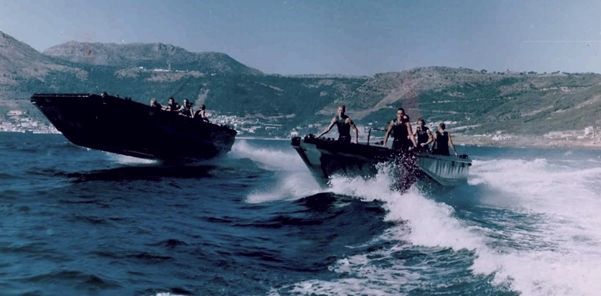
L-24 (left) with Windell, Kay, Winterbottom, Lups,
Volskenk, Daffey
L-25 (right) with Cooke, Moore, Dalton,
Schwartz, Chouler in Simons Bay.
(ABS photo)
A follow up amphibious exercise was scheduled for later in the year at Saldanha. However, by July 19, the state of the conflict in the operational theatre along the Angola border had given rise to operation PRONE. This included an amphibious assault on the Port of Namibe, Angola, which would cut off Cuba’s essential war supplies to the operational area and open a third front that Cuba could not defend. The seaborne landing was STRANDLOPER, and the Namibe attack plan was KWÊVOËL. The seaborne landings would be coordinated with a simultaneous Paratroop air drop to take the Namibe airfield. The Marines would land and form a beach head. The Paratroops would land behind the beach head and move through the beach head, to assault both targets simultaneously during the night. This was to be publicly rehearsed at Walvis Bay as part of Naval Exercise MAGERSFONTEIN. The Naval force in MAGERS FONTEIN included the SAS Maria Van Riebeek, SAS Tafelberg, SAS Drakensberg, and six Strike Craft. The six Strike Craft were the: SAS Frederick Creswell Pennant 1563 (FES, 63, or Boat 3); SAS Jim Fouché; Pennant 1564 (JFE, 64, or Boat 4); SAS Hendrik Mentz Pennant 1567 (HMZ, 67, or Boat 7); P1569 (later called SAS Magnus Malan, MMN 69, or Boat 9, but unnamed at that time as General Magnus Malan was still serving); SAS PW Botha Pennant 1562 (PWB, 62 or Boat 2); SAS Kobie Coetsee Pennant 1568 (KCE, 68, or Boat 8). At that time the Strike Craft Flotilla was divided into two squadrons. Number 1 Squadron was based in Durban and number 2 Squadron was based in Simonstown. Strike Craft FES, JFE, HMZ, and P1569 sailed from Durban in the late afternoon to join Strike Craft PWB and KCE who were part of the 2nd Squadron in Simonstown. The six boats then joined MAGERSFONTEIN in Simonstown. Of interest is that each boat had its own colour patch, with a logo, and boat number. These patches were worn by boat crews on their cold weather jackets. The patch colour was painted on the lower horizontal member of the corresponding Strike Craft’s main mast, making each boat and its crew identifiable.
The Officer in Command of the Naval exercise was COMNAV WEST, Rear Admiral Bennett. His OIC was Captain Green of the SAS Tafelberg. The Commander of the Army Landing Forces (CALF) was Commandant McGill Alexander, the Air Force Mobile Air Operations Team Commander (MOAT) was Major Grant Geddes, and the ABS Commander was Lt. Cdr. Clive Bloom. The boat, ship, and air activities on SAS Tafelberg were under the command of the Ops Officer (OPSO) Lt. Cdr. Zulu Liebenberg, and the boat deck operations were under the command of the Executive Officer (XO) Cdr Tony Absolam.
Operation KWÊVOËL was set for August 28. The politicians then placed it on standby. And on Tuesday, August 16, the cease fire between Cuba, South Africa, and Angola was made official. However, STRANDLOPER / KWÊVOËL remained in place as a contingency operation.
Based on lessons learned from STRANDLOPER, ABS divided into three sections overseen by Lt. Steven King and C.P.O. Tony Devenish: training and selection; operational boats; and beach reconnaissance.
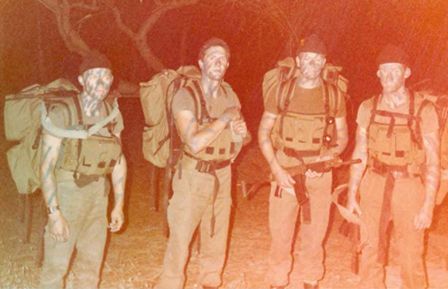
Emil Wiggill, Jacques Visser, Stefan Schoeman,
Campbell Cooke ABS recon team exercises
It was decided that beach landings would have a primary landing ground, with two alternative beaches. A two man ABS recon team would determine which beach would be used and send a full Beach Report to the landing group onboard SAS Tafelberg. The Beach Report was a predetermined list of conditions on the surf, beach environment, and surrounding area. It contained a detailed description of the waves, seabed geography, approach, hazards, weather, and landing area.This gave the D-80 Coxswains a clear picture of the landing ground and its approaches. The list of questions was prepared by all the coxswains before the landing, based on the possible landing sites. Morse signals were also predetermined. The recon team and the boat group each had a copy of the questions. The recon team, having determined the beach for the landing, completed the questionnaire based on the conditions on the ground. This report was relayed by B25 Hopper HF radio from the beach to the boat group as a list of answers. The coxswains on SAS Tafelberg filled in the answers on their copy of the sheet, giving them the picture of the landing ground. The two man recon team had control of the beach area and once the Beach Master landed, he took control of the beach and surrounding area.
Trips started on SAS Drakensberg to set up the operating procedure for launching and recovering Delta boats and Barracudas. The same procedures that were used on SAS Tafelberg were used on SAS Drakensburg.
The third Amphibious Exercise was held off Saldanha in August 1989 as Exercise VLAKWATER. As part of this Navy Task Force 344, which included SAS Tafelberg, SAS Drakensberg, five Strike Craft, and SAS Emily Hobhouse engaged in exercise GRAND SLAM. The landing was scheduled for Monday, August 11, in Danger Bay. Again, the exercise went like clockwork.
At the end of 1989 the conflict was over. The ABS was disbanded with the Marines in March 1990. And this ended the SA Navy’s amphibious warfare capability.
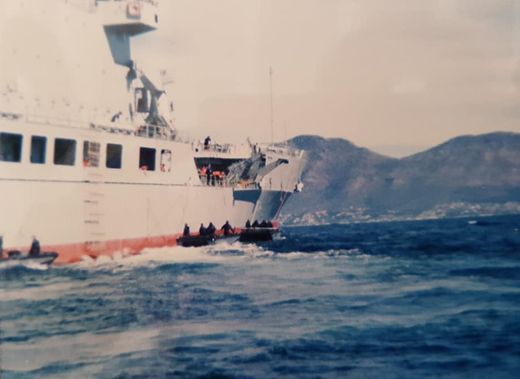
D-80 boats waiting to be recovered
on the SAS Drakensberg, Simons Bay
References:
SAS Tafelberg Logbook, SA Naval Museum
Conversations with Ghosts; the collective memories of the ABS
About the Author
Born in the UK and immigrated to SA in 1977. Joined the SA Marines in 1981 and then joined the Amphibious Boat Squadron in 1986 where he stayed until the unit was disbanded in 1990. Emigrated to the USA in 1996, where he currently lives and works as an attorney.
Return to Journal Index OR Society's Home page
South African Military History Society / scribe@samilitaryhistory.org